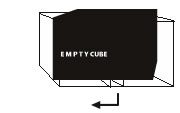HANNES EGGER
APRIL 1, 2016

CONTACTS
https://hannesegger.com
EXHIBITION INFORMATION
Drawing in printed paper, camera, monitor, computer, cables and performers
Photos: © Pedro Tropa
a drawing for a performance: a shared image
Hannes Egger's first project in Portugal, “Public performance”, was hosted by EMPTY CUBE. In it, the artist explored such notions as public vs. private space, as well as the curatorial project itself, as an ephemeral moment in which all spectators may be revealed, while being at the same time instrumental in the revelation of the Other.
The project's title, “Public performance”, suggests a (sometimes contradictory) connection between seeing and being seen, between each individual's uniqueness in the exhibition space and their own exposition as a participant in the artist's work. This stance may lead us to consider the political conditions of legitimisation of authorship and its sharing, as well as the fragmentation of that unity in which we recognise ourselves as “self-aware” following our repositioning as agents of the work itself. For Hannes Egger, the public space offers a range of possibilities that is as broad as its very definition, and can thus create a relational field in the space each individual occupies. His project comprises both singularity and plurality, in a transition between being seen and finding oneself as a participant that is constantly under construction, wavering between the cube's space and the space of the gallery.
“Public performance” was essentially conceived via a predetermination visitors might or might not obey, but which became known to them as soon as each individual picked up a sheet of paper that contained written instructions and an original drawing (different on every sheet). That drawing, quite simple in graphic terms, indicated a body pose that might be performed by each viewer while inside the cube. Here, it should be explained that the cube's back wall hosted a TV screen that disclosed whatever was going on inside it, which implied the presence of a camera operating an immediate connection between outside and inside, between what is seen and who is being seen. Thus the cube becomes a surveillance station that contains the space it surveys within itself. This may remind us of, for instance, Bruce Nauman, both in terms of a work in which he recorded the comings and goings in his studio, as described by Capucine Perrot in her text “Here, I knew I Was Being Watched” 1, or of an older piece, entitled Lived-Taped Video Corridor (1970). However, such references only serve to position Egger's work within recent art history, because here the artist generates a new dimension by influencing the viewer's decision-making capacity at the very moment in which the instructions are being picked up. It is at that crucial and decisive moment that participants ponder, and discuss among themselves, the original drawing, the recommended duration for the peformance and the various poses they can perform; while considering these various issues, they are led to reflect on the exposition of their own bodies. By then, self-determination becomes more than simply self-referential: it turns into part of a universe of individuals who stand at the same threshold. The issue of individual choice is thus shared, made public among the public attending the performance. In this way, Hannes Egger preserves the subjective individuality of each viewer during their divulgation of another individual's set of instructions, creating a paradoxical situation in which the viewing public becomes a movable, transitory category, affected by the actions of each one of its elements. In addition, this shared performance was thoroughly recorded, yielding a set of archival materials that may be used in another work.
A public performance for viewers that are part of the performance-viewing public.
João Silvério
April 2016







